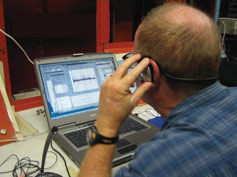
Handy Links
SLAC News Center
SLAC Today
- Subscribe
- Archives: Feb 2006-May 20, 2011
- Archives: May 23, 2011 and later
- Submit Feedback or Story Ideas
- About SLAC Today
SLAC News
Lab News
- Interactions
- Lightsources.org
- ILC NewsLine
- Int'l Science Grid This Week
- Fermilab Today
- Berkeley Lab News
- @brookhaven TODAY
- DOE Pulse
- CERN Courier
- DESY inForm
- US / LHC
SLAC Links
- Emergency
- Safety
- Policy Repository
- Site Entry Form

- Site Maps
- M & O Review
- Computing Status & Calendar
- SLAC Colloquium
- SLACspeak
- SLACspace
- SLAC Logo
- Café Menu
- Flea Market
- Web E-mail
- Marguerite Shuttle
- Discount Commuter Passes
-
Award Reporting Form
- SPIRES
- SciDoc
- Activity Groups
- Library
Stanford
Around the Bay
Remote Participation Moves Forward
 Earlier this month, a group of SLAC scientists took a step into the future of international collaboration when they launched a
remote participation session that connected SLAC with the control room of KEK's Accelerator Test Facility (ATF).
Earlier this month, a group of SLAC scientists took a step into the future of international collaboration when they launched a
remote participation session that connected SLAC with the control room of KEK's Accelerator Test Facility (ATF).
Though 5,300 miles apart, two SLAC teams—one at SLAC and one at KEK in Japan—were able to work simultaneously through remote participation, thanks to the ingenious use of available software, namely WebEx and Skype.
To make this state-of-the-art connection work, one desktop in the PEP Control Room was connected to a server in the ATF control room via WebEx conferencing. This allowed the group in California to view the live desktop in Japan. It also allowed researchers at SLAC to share their desktop images with those in Japan when interesting results were discovered.
The group was studying the performance of new Beam Position Monitor electronics built for the ATF by a KEK/Fermilab/SLAC collaborative effort, and in particular the latest hardware installed by a team from Fermilab led by Manfred Wendt and Peter Prieto. The new electronics system has enabled the gathering of remarkably accurate information about beam position with less than one micron resolution.
A second desktop was connected to the control room using the freeware Skype, an audio/visual communication platform. Because the phone lines into the ATF control room must remain open for safety reasons, the team used this platform to communicate via the Internet.
According to Engineering Physicist Mark Woodley, the setup was invaluable because it allowed the team at SLAC to analyze data and ask for beam adjustments as if they were in KEK's control room. For two weeks, teams at SLAC worked eight hour shifts and made significant progress in their research.
"It allowed people who couldn't be there to learn how a lab is run in Japan," said Sergei Seletskiy, a SLAC scientist who worked three shifts. "I learned a lot and it was a very positive experience."
Though WebEx and Skype software is readily available to anyone, the SLAC and ATF group at KEK used it in an innovative way, foreshadowing future remote participation efforts. Collaboration between teams thousands of miles apart, working real-time shifts, is a new experience for SLAC researchers and the first step towards bigger and better collaborations in the future.
Similar systems are currently under development for other collaborations; in particular Fermilab has recently built a new control center that will allow for seamless remote participation for researchers at the Large Hadron Collider, working both on the Compact Muon Spectrometer (CMS) experiment and on the accelerator.
Also, a Global Accelerator Network using a Multipurpose Visual Laboratory is being developed for use in anticipation of the International Linear Collider. The program is to be a mobile communication center that will simulate a control room and connect to standard measurement equipment, making them available to a remote client. Although this suite of hardware and software applications is not yet ready for beta testing at existing accelerators, the system promises to allow more collaboration with what Woodley calls "super deluxe" quality in the future.
—Ken Kingery, SLAC Today, June 13, 2007
Above image: Mark Woodley interacts remotely with the KEK control room. (Click on image for larger version.)